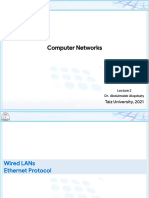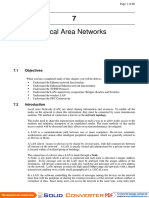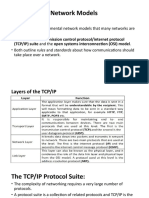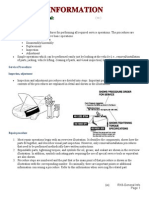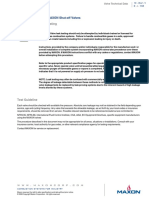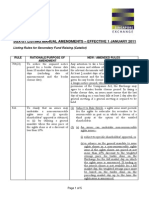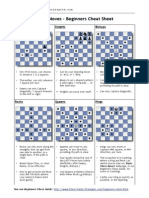0 ratings0% found this document useful (0 votes)
47 viewsEE-379 Embedded Systems and Applications: Introduction To Ethernet
EE-379 Embedded Systems and Applications: Introduction To Ethernet
Uploaded by
John Howard1. The document discusses Ethernet networking standards including frame structure, physical layers, and media access control. It provides a history of Ethernet's development and increasing speeds over time.
2. Key aspects covered include the OSI 7-layer model, TCP/IP protocol stack, Ethernet frame format, cabling types and specifications, and CSMA/CD MAC addressing and collision protocols.
3. Details are given on data encapsulation during transmission, Ethernet's carrier sense multiple access with collision detection operation, and 48-bit MAC addressing using unique vendor codes.
Copyright:
© All Rights Reserved
Available Formats
Download as PDF, TXT or read online from Scribd
EE-379 Embedded Systems and Applications: Introduction To Ethernet
EE-379 Embedded Systems and Applications: Introduction To Ethernet
Uploaded by
John Howard0 ratings0% found this document useful (0 votes)
47 views25 pages1. The document discusses Ethernet networking standards including frame structure, physical layers, and media access control. It provides a history of Ethernet's development and increasing speeds over time.
2. Key aspects covered include the OSI 7-layer model, TCP/IP protocol stack, Ethernet frame format, cabling types and specifications, and CSMA/CD MAC addressing and collision protocols.
3. Details are given on data encapsulation during transmission, Ethernet's carrier sense multiple access with collision detection operation, and 48-bit MAC addressing using unique vendor codes.
Original Description:
Lecture on Ethernet
Original Title
Lec16 Ethernet
Copyright
© © All Rights Reserved
Available Formats
PDF, TXT or read online from Scribd
Share this document
Did you find this document useful?
Is this content inappropriate?
1. The document discusses Ethernet networking standards including frame structure, physical layers, and media access control. It provides a history of Ethernet's development and increasing speeds over time.
2. Key aspects covered include the OSI 7-layer model, TCP/IP protocol stack, Ethernet frame format, cabling types and specifications, and CSMA/CD MAC addressing and collision protocols.
3. Details are given on data encapsulation during transmission, Ethernet's carrier sense multiple access with collision detection operation, and 48-bit MAC addressing using unique vendor codes.
Copyright:
© All Rights Reserved
Available Formats
Download as PDF, TXT or read online from Scribd
Download as pdf or txt
0 ratings0% found this document useful (0 votes)
47 views25 pagesEE-379 Embedded Systems and Applications: Introduction To Ethernet
EE-379 Embedded Systems and Applications: Introduction To Ethernet
Uploaded by
John Howard1. The document discusses Ethernet networking standards including frame structure, physical layers, and media access control. It provides a history of Ethernet's development and increasing speeds over time.
2. Key aspects covered include the OSI 7-layer model, TCP/IP protocol stack, Ethernet frame format, cabling types and specifications, and CSMA/CD MAC addressing and collision protocols.
3. Details are given on data encapsulation during transmission, Ethernet's carrier sense multiple access with collision detection operation, and 48-bit MAC addressing using unique vendor codes.
Copyright:
© All Rights Reserved
Available Formats
Download as PDF, TXT or read online from Scribd
Download as pdf or txt
You are on page 1of 25
1
EE-379 Embedded Systems and Applications
Introduction to Ethernet
Cristinel Ababei
Department of Electrical Engineering, University at Buffalo
Spring 2013
Note: This course is offered as EE 459/500 in Spring 2013
Overview
Open Systems Interconnection (OSI)
The Internet
Internet Protocol (TCP/IP Protocol)
Ethernet History
Ethernet
Frame structure
Physical layer
MAC
2
Open Systems Interconnection (OSI)
Model
The Open Systems Interconnection (OSI)
model is a prescription of characterizing and
standardizing the functions of a
communications system in terms of
abstraction layers.
Similar communication functions are grouped
into logical layers.
A layer serves the layer above it and is served
by the layer below it.
OSI 7 Layers
3
1. Physical layer:
Defines electrical and physical specifications for devices
2. Data Link Layer (DLL): provides the functional and
procedural means to transfer data between network
entities and to detect and possibly correct errors. Has 2
sublayers:
Logical Link Control (LLC), upper
Medium Access Control (MAC), lower
3. Network layer:
Provides the functional and procedural means of transferring
variable length data sequences from a source host on one
network to a destination host on a different network
4. Transport layer:
Provides transparent transfer of data between end users,
providing reliable data transfer services to the upper layers
OSI 7 Layers
OSI 7 Layers
5. Session layer:
Controls the dialogues (connections) between computers.
It establishes, manages and terminates the connections
between the local and remote application.
It provides for full-duplex, half-duplex, or simplex operation, and
establishes checkpointing, adjournment, termination, and
restart procedures.
6. Presentation layer:
Provides encryption services, decryption, data compression, and
decompression.
7. Application layer:
Checks resource usability and synchronization with the remote
partner.
4
OSI Model Examples, View 1
OSI Model Examples, View 2
5
Overview
Open Systems Interconnection (OSI)
The Internet
Internet Protocol (TCP/IP Protocol)
Ethernet History
Ethernet
Frame structure
Physical layer
MAC
The Internet
The Internet is a global system of interconnected
computer networks that use the standard
Internet Protocol suite (TCP/IP) to serve billions
of users worldwide.
It is a network of networks that consists of
millions of private, public, academic, business,
and government networks, of local to global
scope, that are linked by a broad array of
electronic, wireless and optical networking
technologies.
6
Simplified Internet Architecture
Simplified Internet Architecture
7
Overview
Open Systems Interconnection (OSI)
The Internet
Internet Protocol (TCP/IP Protocol)
Ethernet History
Ethernet
Frame structure
Physical layer
MAC
Internet Protocol (or TCP/IP Protocol)
The Internet Protocol suite is the set of
communications protocols used for the
Internet and similar networks.
It is the most popular protocol stack for wide
area networks.
It is commonly known as TCP/IP, because of
its most important protocols:
Transmission Control Protocol (TCP)
Internet Protocol (IP)
8
Internet Protocol 4 Layers
1. Link layer:
Contains communication technologies for a local
network.
2. Internet layer (IP):
Connects local networks, thus establishing
internetworking.
3. Transport layer:
Handles host-to-host communication.
4. Application layer:
Contains all protocols for specific data communications
services on a process-to-process level.
It focuses more on network services, APIs, utilities, and
operating system environments.
TCP/IP vs. OSI
9
Data Encapsulation
A network packet is nothing more than a chunk of
data that an application wants to deliver to
another system on the network.
This chunk of data has information added to the
front and back that contains instructions for
where the data needs to go and what the
destination system should do with it once it
arrives.
The addition of this routing and usage
information is called encapsulation.
Data Encapsulation
10
Data Encapsulation
Overview
Open Systems Interconnection (OSI)
The Internet
Internet Protocol (TCP/IP Protocol)
Ethernet History
Ethernet
Frame structure
Physical layer
MAC
11
Ethernet History
The Original Design of Ethernet from Robert Metcalfe
Ethernet History: Speed matters - how Ethernet
went from 3Mbps to 100Gbps and beyond
On May 22, 1973, Bob Metcalfe at Xerox PARC, Palo Alto CA,
documented the invention of Ethernet in a memo, which described
communication across different "ethers" - including cable, telephone,
and radio - building on the ALOHAnet protocol
Bob Metcalfe, David Boggs, and Tat Lam built the first Ethernet
prototype at 2.94 Mbps
1980, Digital, Intel, and Xerox developed the standard of 10Mpbs DIX
Ethernet (a.k.a. Ethernet II)
1992, the Grand Junction Network Company brought up the
structure of 100Mbps Ethernet
1998, addressed the standard of Gigabit Ethernet
2002, 10 Gigabit standard published
2002-2010 40 Gigabit proposals
2010 100 Gigabit
Terabit Ethernet?
12
Speed of Ethernet
History
13
History
History
14
Overview
Open Systems Interconnection (OSI)
The Internet
Internet Protocol (TCP/IP Protocol)
Ethernet History
Ethernet
Frame structure
Physical layer
MAC
Ethernet
Carrier-sense multiple access/carrier detect
(CSMA/CD) protocol:
1. Listen to the cable
2. If nobodys there, start talking
3. If someone interrupts, stop, and retry after a random
time
The Ethernet Protocol is made up of a number of
components:
1. Structure of Ethernet frames
2. Physical Layer (i.e., the Media)
3. MAC operation
15
1. Frame Structure
Frame Structure
Information is sent around an Ethernet network in discreet
messages known as frames.
The frame structure consists of the following fields:
1. The Preamble - This consists of seven bytes, all of the form
"10101010". This allows the receiver's clock to be synchronized
with the sender's.
2. The Start Frame (SOF) Delimiter - This is a single byte
("10101011") which is used to indicate the start of a frame.
3. The Destination Address - This is the address of the intended
recipient of the frame. The addresses in 802.3 use globally
unique hardwired 48 bit addresses.
4. The Source Address - This is the address of the source, in the
same form as above.
5. Type of packet, 0x0800 for IP, 0x0806 for ARP, etc. Length of the
data in the Ethernet frame can be anything from 0 to 1500
bytes.
16
6. Data - This is the information being sent by the frame.
7. Pad - 802.3 frame must be at least 64 bytes long, so if the data is
shorter than 46 bytes, the pad field must compensate. The reason
for the minimum length lies with the collision detection mechanism.
In CSMA/CD the sender must wait at least two times the maximum
propagation delay before it knows that no collision has occurred. If a
station sends a very short message, then it might release the ether
without knowing that the frame has been corrupted. 802.3 sets an
upper limit on the propagation delay, and the minimum frame size is
set at the amount of data which can be sent in twice this figure.
8. Checksum - This is used for error detection and recovery.
Frame Structure
2. Physical Layer
Concerned with the low level electronic way in
which the signals are transmitted.
Signals are transmitted using Manchester
Phase Encoding (MPE). This encoding is used
to ensure that clocking data is sent along with
the data, so that the sending and receiving
device clocks are in sync.
Logic levels are transmitted along the medium
using voltage levels of 0.85V.
17
Types of Ethernet Cables
Cable type Max speed Max Length Operating
Frequency
CAT5 100 Mbps 100 m 100 MHz
CAT5e 1 Gbps 100 m 100 MHz
CAT6 10 Gbps 50 m 250 MHz
CAT6a 10 Gbps 100 m 500 MHz
All backwards-compatible
CAT7 in the works, 40Gbps and 100Gbps
Cable Structure
18
Cable
Structure
Cable
Structure
19
Cable Structure
3. Media Access Control (MAC)
To send a frame, a station on an 802.3 network
first listens to check if the medium is busy.
If it is, then, the station uses the 1-persistent strategy,
and transmits after only a short fixed delay (the inter-
frame gap) after the medium becomes idle.
If there is no collision, then this message will be sent
normally.
If the device detects a collision however, the frame
transmission stops and the station sends a jamming
signal to alert other stations of the situation. The
station then decides how long to wait before re-
sending using a truncated binary exponential backoff
algorithm.
After 16 continuous collisions, the MAC layer gives up
and reports a failure to the layer above.
20
MAC Flow Graph
How addressing takes place in Ethernet
Addressing in Ethernet takes place with MAC Addresses - 6
byte long (48 bits)
MAC address is also called Ethernet address or Hardware
address or Physical address
This address is of the physical Ethernet card or NIC
(network information card) which is installed on a system
Its programmed into the chip of a network card (burned
into the ROM of the NIC)
21
Ethernet (MAC) Addresses
Address fields
48 bits 281 trillion (world population: 6.5 billion)
Bits 4824: Vendor code
Bit 41: 0=ordinary, 1=group (broadcast) address
Bits 230: Serial number
Example:
$ ifconfig eth0
eth0 Ethernet HWaddr 00:08:74:23:CC:AB
OUI (Organizationally Unique Identifier):
00:08:74 is Dell Computer
Address FF:FF:FF:FF:FF:FF is broadcast
An Ethernet Packet (Frame)
00d006269c00 Destination MAC address (router)
00087423ccab Source MAC address (desktop)
0800 Type = IP packet
45 IPv4, 5 word (20-byte) header
00 Normal service
0028 Total length = 40 bytes
c31c Identification (unique)
4000 Dont Fragment
4006 hops to live
06 TCP protocol
3ff1 Header checksum (ones complement)
803b1372 Source IP 128.59.19.114 (desktop)
40ec6329 Destination IP 64.236.99.41
deac 0050 bf49 9ba6 a1a4 8bed 5010 ffff 1093 0000
22
IP Header Checksum Computation
IP Header
23
IP Addresses (layer 3 Network layer)
32-bit (4 byte) software stored address: assigned
to represent the same NIC as MAC address
represents
The 32-bit IP address is like a shorter nickname
for the 48-bit MAC address
Main point in differentiating IP from MAC
addresses:
Direct-connected transmission uses Layer 2 - MAC
addresses for frame delivery
Routed transmission uses Layer 3 - IP addresses for
packet delivery
IP Addresses
32 bits 4 billion (world population: 6.5 billion)
First n bits indicate network (n = 8, 16, 24)
For example, Google owns the range:
173.194.0.0 - 173.194.255.255
Magical addresses:
127.0.0.1 Me
192.168.x.x Never assigned worldwide
10.x.x.x Never assigned worldwide
255.255.255.255 Broadcast
24
MAC Addresses vs. IP Addresses
MAC address
Its just a manufacturer code and a serial number
There's no structure to it beyond that, and so no way
to route packets efficiently
MAC address is used purely to address machines on a
local network segment
IP address
Introduced to address machines outside a network
segment
IP addresses have an inherent hierarchy with the use
of subnet masks, etc., allowing large networks to be
addressed in a block for efficient routing
User Datagram Protocol (UDP)
UDP is one of the core members of the Internet
Protocol suite
With UDP, computer applications can send messages,
(referred to as datagrams), to other hosts on an
Internet Protocol (IP) network without prior
communications to set up special transmission
channels or data paths
It has no handshaking dialogues exposes any
unreliability of the underlying network protocol to the
user's program
UDP is suitable when error checking and correction is
either not necessary or performed in the application
25
UDP Packets
Credits, References
Ethernet Introduction, Ross MCIlroy, 2004;
http://www.dcs.gla.ac.uk/~ross/Ethernet/index.htm
Cable images;
http://image.pinout.net/pinout_network_rj45_files/
LPC17xx user manual, 2010;
http://www.nxp.com/documents/user_manual/UM10360.pdf
And many others (see lab#7 for more references)
You might also like
- ACYAVA1 Comprehensive Examination Quiz Instructions: Started: Jun 4 at 13:00Document37 pagesACYAVA1 Comprehensive Examination Quiz Instructions: Started: Jun 4 at 13:00Joel Kennedy BalanayNo ratings yet
- Answer - Regular CS306 Computer Networks May 2019Document11 pagesAnswer - Regular CS306 Computer Networks May 201911712077 NIVA DILEEP100% (1)
- Econ 2010 Final Essay QuestionsDocument6 pagesEcon 2010 Final Essay QuestionsBrandon Lehr0% (1)
- Occupational Safety & Health (DOSH) : DepartmentDocument34 pagesOccupational Safety & Health (DOSH) : DepartmentDzuraineyBtAbuBakarNo ratings yet
- Instructiuni Utilizare Seif ElectronicDocument2 pagesInstructiuni Utilizare Seif ElectronicMihai Raluca ElenaNo ratings yet
- Total Parenteral NutritionDocument41 pagesTotal Parenteral Nutritionrana adnan ejaz100% (3)
- 2696 - INFO - BacTALERT - Seeded StudyDocument11 pages2696 - INFO - BacTALERT - Seeded StudyRickyNo ratings yet
- Chapter 4 NetworkingDocument57 pagesChapter 4 NetworkingAyush KakdeNo ratings yet
- BSSC - DCNDocument23 pagesBSSC - DCNamsousefulNo ratings yet
- Introduction To Computer NetworksDocument118 pagesIntroduction To Computer Networkskaynaan YareNo ratings yet
- 2.1 Giới thiệu lớp liên kết dữ liệuDocument28 pages2.1 Giới thiệu lớp liên kết dữ liệuDũng PhạmNo ratings yet
- Unit - 3 Data Link LayerDocument6 pagesUnit - 3 Data Link LayerVaishnavi TawareNo ratings yet
- S7 Ethernet-Local Area Network: GROUP: 4960 Members: William Obaco Alexander Méndez Raúl SaltosDocument47 pagesS7 Ethernet-Local Area Network: GROUP: 4960 Members: William Obaco Alexander Méndez Raúl SaltosByron Xavier Lima CedilloNo ratings yet
- Day 14 Installation of NIC Day 15, 16 Peer To Peer NetworkingDocument22 pagesDay 14 Installation of NIC Day 15, 16 Peer To Peer NetworkingVinod SoniNo ratings yet
- EthernetDocument10 pagesEthernetmariam.rekikNo ratings yet
- CN Theory Assignment 3 SolDocument8 pagesCN Theory Assignment 3 SolfaujiantonyNo ratings yet
- ch6 Network PDFDocument28 pagesch6 Network PDFomerNo ratings yet
- Computer NetworksDocument21 pagesComputer NetworksAran Utkarsh100% (1)
- Lect Net10Document31 pagesLect Net10omarmagdyahmed7474No ratings yet
- Network Sizes and IEEE 802.X StandardsDocument28 pagesNetwork Sizes and IEEE 802.X StandardsVim SamNo ratings yet
- osi modelDocument22 pagesosi modelVerma JagdeepNo ratings yet
- The FNDocument73 pagesThe FNMie NgeNo ratings yet
- ch5,6Document54 pagesch5,6animut0934No ratings yet
- IT Notes Unit 5Document14 pagesIT Notes Unit 5Deepankar Anil KumarNo ratings yet
- Computer Networks Computer Networks: Taiz University, 2021 Taiz University, 2021Document54 pagesComputer Networks Computer Networks: Taiz University, 2021 Taiz University, 2021alshamiripooi100No ratings yet
- LAN and Ethernet Basics - Deepak George: OSI Network LayersDocument12 pagesLAN and Ethernet Basics - Deepak George: OSI Network LayersUseful Videos DevotionalNo ratings yet
- DCC PTT 2 Answer BankDocument9 pagesDCC PTT 2 Answer BankKhan Rahil AhmedNo ratings yet
- Computer Network Long Questions & AnswerDocument12 pagesComputer Network Long Questions & Answersravan123No ratings yet
- C CCC PPDocument20 pagesC CCC PPSwtz Zraonics100% (1)
- Curs 2Document37 pagesCurs 2Zaha GeorgeNo ratings yet
- Week 3 OSI Models and Protocols - PPTDocument19 pagesWeek 3 OSI Models and Protocols - PPTMary Charlene ValmonteNo ratings yet
- Standards and Network Protocols: M.C. Juan Carlos Olivares RojasDocument109 pagesStandards and Network Protocols: M.C. Juan Carlos Olivares RojasrizismNo ratings yet
- NetworkDocument82 pagesNetworkDavidoffNo ratings yet
- Week 3Document5 pagesWeek 3hiren_keepsmilingNo ratings yet
- One Liner OctDocument18 pagesOne Liner OctPuneet ChandraNo ratings yet
- Ccna Ipv4 AddressingDocument103 pagesCcna Ipv4 AddressingntimamaoNo ratings yet
- Data Link Issues: Relates To Lab 2Document17 pagesData Link Issues: Relates To Lab 2William PowellNo ratings yet
- 2.2 Standards and NetworkingDocument43 pages2.2 Standards and NetworkingallaboutanalogNo ratings yet
- Assignment On NetworksDocument7 pagesAssignment On NetworksLimitless StatusNo ratings yet
- CA Ex S1M09 EthernetDocument136 pagesCA Ex S1M09 Ethernethttp://heiserz.com/No ratings yet
- Assignment: SUBMITTED FROM: Yousra Nur Obaid ID:19204025 Submitted To: Md. HasanuzamanDocument17 pagesAssignment: SUBMITTED FROM: Yousra Nur Obaid ID:19204025 Submitted To: Md. HasanuzamanFahad RuhulNo ratings yet
- Local Area Networks: 7.1 ObjectivesDocument66 pagesLocal Area Networks: 7.1 ObjectivesAhmedNo ratings yet
- Assignment: SUBMITTED FROM: Fahad Ruhul Amin Bhuiyan ID:18304017 Submitted To: Md. HasanuzamanDocument17 pagesAssignment: SUBMITTED FROM: Fahad Ruhul Amin Bhuiyan ID:18304017 Submitted To: Md. HasanuzamanFahad RuhulNo ratings yet
- Broadcast Communication Networks: Version 2 CSE IIT, KharagpurDocument13 pagesBroadcast Communication Networks: Version 2 CSE IIT, Kharagpurdarebusi1No ratings yet
- Course Contents: Data Communications Grade Prof. Dr. Hassan H. Soliman Dr. Mostafa Elgayar Part 5 P1Document20 pagesCourse Contents: Data Communications Grade Prof. Dr. Hassan H. Soliman Dr. Mostafa Elgayar Part 5 P1saher waleedNo ratings yet
- Osi ModelDocument20 pagesOsi Modelaneezashahid3469No ratings yet
- VSATDocument11 pagesVSATShashwat TiwariNo ratings yet
- PPT Week 5Document59 pagesPPT Week 5GERALDUS BERNICKO CLIFF HARSONONo ratings yet
- IPv 4Document20 pagesIPv 42224 Momynul IslamNo ratings yet
- Comptia Network+ Study SheetDocument30 pagesComptia Network+ Study SheetDan Sheets100% (5)
- Fundamental Network ModelsDocument9 pagesFundamental Network ModelsSailas Khulumani TshabanguNo ratings yet
- IT Infrastructures Computer Communication NetworksDocument39 pagesIT Infrastructures Computer Communication Networkssohilnandwani09No ratings yet
- Komunikasi Data Dan Jaringan Komputer - Pertemuan 4Document38 pagesKomunikasi Data Dan Jaringan Komputer - Pertemuan 4Ksatria AFKNo ratings yet
- Section 1:-Introduction To Networking Concepts NetworkingDocument35 pagesSection 1:-Introduction To Networking Concepts NetworkingManoj SainiNo ratings yet
- DCN Unit - 4Document115 pagesDCN Unit - 4Rohan SaiNo ratings yet
- Unit-2 ANP MSDocument69 pagesUnit-2 ANP MSKeep learningNo ratings yet
- CCNA Crash Course Day 01Document198 pagesCCNA Crash Course Day 01JJohnny100% (1)
- MMT - Chương 2 - EN - Ethernet SwitchingDocument58 pagesMMT - Chương 2 - EN - Ethernet SwitchingYến ĐỗNo ratings yet
- 4 AaDocument55 pages4 AaericcostermboyaNo ratings yet
- Networking 1Document28 pagesNetworking 1rahul3071No ratings yet
- IOT Module2Document62 pagesIOT Module2PriyanshuNo ratings yet
- Chapter 8 Communication ProtocolsDocument23 pagesChapter 8 Communication Protocolsarnel vence l. zarzaNo ratings yet
- Submitted by Abdelwahab MohamedDocument13 pagesSubmitted by Abdelwahab Mohamedalmuhtarif.egyptian.yahoo.comNo ratings yet
- Cisco Certified Network Associate (CCNA) and Cisco Certified Network Professional (CCNP): Mastering Network Automation and Programmability Study GuideFrom EverandCisco Certified Network Associate (CCNA) and Cisco Certified Network Professional (CCNP): Mastering Network Automation and Programmability Study GuideNo ratings yet
- CompTIA Network+ (N10-009) Study Guide: Comprehensive Exam Preparation and Key Concepts for Network ProfessionalsFrom EverandCompTIA Network+ (N10-009) Study Guide: Comprehensive Exam Preparation and Key Concepts for Network ProfessionalsNo ratings yet
- Introduction to Internet & Web Technology: Internet & Web TechnologyFrom EverandIntroduction to Internet & Web Technology: Internet & Web TechnologyNo ratings yet
- Delhi Metro PresentationDocument26 pagesDelhi Metro PresentationJohn HowardNo ratings yet
- Essay LayoutDocument6 pagesEssay LayoutJohn HowardNo ratings yet
- Rx8 General Info ManualDocument49 pagesRx8 General Info ManualJohn HowardNo ratings yet
- Vane Shear TestDocument14 pagesVane Shear TestJohn HowardNo ratings yet
- DMRCDocument15 pagesDMRCJohn HowardNo ratings yet
- TSQ GlossaryDocument255 pagesTSQ GlossaryJohn HowardNo ratings yet
- Shwachman-Diamond Syndrome in A Child Presenting With Cystic Fibrosis-Type Symptoms and A False-Positive Sweat TestDocument6 pagesShwachman-Diamond Syndrome in A Child Presenting With Cystic Fibrosis-Type Symptoms and A False-Positive Sweat TestJohn HowardNo ratings yet
- Trump University - Fortune Without Fear - Real Estate Riches in An Unceertain MarketDocument94 pagesTrump University - Fortune Without Fear - Real Estate Riches in An Unceertain MarketJohn HowardNo ratings yet
- Product Sheet: 970 Smartradar AtiDocument4 pagesProduct Sheet: 970 Smartradar AtiJohn HowardNo ratings yet
- Typical Loads For Common Electrical EquipmentDocument3 pagesTypical Loads For Common Electrical EquipmentJohn HowardNo ratings yet
- Characteristics: 5 4 3 2 1 N/A: Student Evaluation FormDocument1 pageCharacteristics: 5 4 3 2 1 N/A: Student Evaluation FormJohn HowardNo ratings yet
- Maxon M PAKT Iom 2007 08Document5 pagesMaxon M PAKT Iom 2007 08John HowardNo ratings yet
- LADS MaxonBurnersDocument1 pageLADS MaxonBurnersJohn HowardNo ratings yet
- Maxon Smartfire Control System SpecDocument12 pagesMaxon Smartfire Control System SpecJohn HowardNo ratings yet
- Maxon M PAKT Bro 2007 08Document4 pagesMaxon M PAKT Bro 2007 08John HowardNo ratings yet
- E-Leak TestingDocument3 pagesE-Leak TestingItziar MinondoNo ratings yet
- What Is VSWR?Document5 pagesWhat Is VSWR?John HowardNo ratings yet
- DIN Controller and Indicator: Product ManualDocument156 pagesDIN Controller and Indicator: Product ManualJohn HowardNo ratings yet
- CENTUM VP Fundamentals For Operation: Day 1 Training Module Code: VPOF Duration: 5 DaysDocument38 pagesCENTUM VP Fundamentals For Operation: Day 1 Training Module Code: VPOF Duration: 5 DaysJohn HowardNo ratings yet
- AnalogiesDocument10 pagesAnalogiesLam Tran67% (3)
- Honeywell Industrial Combustion Emea - Components Technical CatalogueDocument129 pagesHoneywell Industrial Combustion Emea - Components Technical CatalogueJohn HowardNo ratings yet
- SGX-ST Listing Manual Amendments - Effective 1 January 2011: Listing Rules For Secondary Fund Raising (Catalist)Document5 pagesSGX-ST Listing Manual Amendments - Effective 1 January 2011: Listing Rules For Secondary Fund Raising (Catalist)John HowardNo ratings yet
- Chess Moves Beginners Cheat SheetDocument1 pageChess Moves Beginners Cheat SheetJohn HowardNo ratings yet
- The Business Model CanvasDocument2 pagesThe Business Model CanvasJohn HowardNo ratings yet
- Loic Wacquant Slavery To IncarcerationDocument20 pagesLoic Wacquant Slavery To IncarcerationJohn HowardNo ratings yet
- XII Unit Test 3 (For All Batches)Document2 pagesXII Unit Test 3 (For All Batches)John HowardNo ratings yet
- BIR Form No. 1700Document2 pagesBIR Form No. 1700mijareschabelita2No ratings yet
- 2217 Brief IntroductionDocument11 pages2217 Brief IntroductionAnonymous pcanQ3No ratings yet
- STRATEGIC PLAN FOR SUCsDocument3 pagesSTRATEGIC PLAN FOR SUCsgr.4pascalNo ratings yet
- 20 SOP For Transportation To Deliver Defect Free ProdDocument4 pages20 SOP For Transportation To Deliver Defect Free ProdQAD LotusNo ratings yet
- Industry ProfileDocument8 pagesIndustry ProfileVamsi SakhamuriNo ratings yet
- Chapter 1 - FunctionsDocument19 pagesChapter 1 - FunctionsWan Shahirah100% (2)
- Meraki + Umbrella Better Together: GTM KickoffDocument22 pagesMeraki + Umbrella Better Together: GTM KickoffSon PhanNo ratings yet
- Gen I GF1100 ManualDocument44 pagesGen I GF1100 ManualShag ShaggyNo ratings yet
- DatasheetDocument15 pagesDatasheetPablo Alberto Gutiérrez VillaNo ratings yet
- Observation of Teaching and Learning in Actual School EnvironmentDocument16 pagesObservation of Teaching and Learning in Actual School EnvironmentMariver LlorenteNo ratings yet
- Purchase and Sale ContractDocument2 pagesPurchase and Sale Contractjacq hungNo ratings yet
- Assignment HypersensitivityDocument3 pagesAssignment HypersensitivityNurzatul syamim busriNo ratings yet
- How TikTok Reads Your Mind - The New York TimesDocument8 pagesHow TikTok Reads Your Mind - The New York Timesjoe smithNo ratings yet
- GLPM Mi 10991790enDocument36 pagesGLPM Mi 10991790enAnton LyakhovNo ratings yet
- Exercise 1. JobsDocument2 pagesExercise 1. JobsARGELIO PECH PUC GIEZINo ratings yet
- Immediate download Ubuntu Linux Bible 10th Edition Christopher Negus And David Clinton ebooks 2024Document60 pagesImmediate download Ubuntu Linux Bible 10th Edition Christopher Negus And David Clinton ebooks 2024nayimrebel63100% (9)
- Channel Partner - Invoice Format-Trivedha Brokers Invoice RevDocument1 pageChannel Partner - Invoice Format-Trivedha Brokers Invoice RevCS Mohammed SlatewalaNo ratings yet
- 13-th International Mathematical Olympiad: Bratislava - Zilina, Czechoslovakia, July 10-21, 1971Document1 page13-th International Mathematical Olympiad: Bratislava - Zilina, Czechoslovakia, July 10-21, 1971Fachni RosyadiNo ratings yet
- ANNAMMADocument1 pageANNAMMAAnna Mary MarkoseNo ratings yet
- PHS Bearing DetailsDocument9 pagesPHS Bearing DetailsNandan DesignNo ratings yet
- Swaraj: S R NosDocument2 pagesSwaraj: S R NosDadasaheb MoreNo ratings yet
- Combined Emotional Socialization Training and Family Accommodation Modification - Impact On Emotional Regulation and Anxiety Symptoms in Anxious ChildrenDocument13 pagesCombined Emotional Socialization Training and Family Accommodation Modification - Impact On Emotional Regulation and Anxiety Symptoms in Anxious Childrendecomoraes4275No ratings yet
- Abb Parts Fiser68261899 PDFDocument2 pagesAbb Parts Fiser68261899 PDFsuzell9fiorella9ascaNo ratings yet
- Jadwal Jam Pertandingan Ku-12Document2 pagesJadwal Jam Pertandingan Ku-12Nur MurtomoNo ratings yet
























